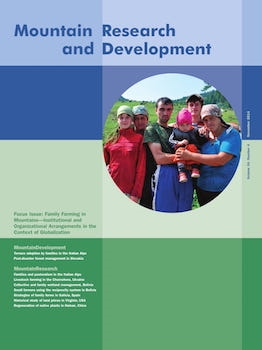Landslide Ecology by Lawrence R. Walker and Aaron B. Shiels. Cambridge, United Kingdom: Cambridge University Press, 2013. xiv + 300 pp. £ 35.00, US$ 60.00. ISBN 978-0-521-17840-2.
Landslides: Types, Mechanisms and Modeling, edited by John J. Clague and Douglas Stead. Cambridge, United Kingdom: Cambridge University Press, 2012. xiii + 420 pp. £ 95.00, US$ 150.00. ISBN 978-1-107-00206-7.
Walker and Shiels's Landslide Ecology is a valuable and pioneering work that aims to construct a new area of bioscience and might more properly be entitled “Landslide Geoecology.” The book begins not with biological colonization and the species of disturbed habitats, but with the physical qualities of landslides and landslide habitats. It concludes with the problems of living with landslides, addressed after the manner of Sidle, who is much cited (Sidle and Ochai 2006). The biological component takes center stage only in Chapters 4 and 5. However, the book is well written, well designed, readable, and accessible; each chapter is prefaced by a very helpful list of key points and then completed with a thoughtful summative conclusion. This makes the book a valuable resource for education.
The special feature of this book is that it attempts to draw together the few and scattered works on the “emerging discipline” (pp xii) of landslide ecology, apparently only 1% of the literature (p 2). The argument is that landslides—abundant on about 4% of the Earth's surface (p 19)—provide important ruderal habitats that support the primary colonizer species of succession, as well as complex niches that foster biodiversity and increase opportunities for ecological invaders and ecological change. The authors document how anthropogenic processes have accelerated landscape activity, which they suggest may affect up to 2% per annum of forested areas in mountainous terrain (p 178). If this is set against data from Nepal's Sal (Shorea robusta) forest, which show that it can take up to 35 years for plant and microbial biomass to recover from landslide disturbance, and between 100 and 150 years for soil organic carbon and nitrogen to reach pre-landslide levels (Mandal 2012), landslides are clearly ecologically important and merit more attention than they have thus far received. Walker and Shiels demonstrate that their new field of landslide ecology has validity in scientific terms, for landscape management, and, although they do not index the term, for bioengineering. Their definition of the scope of the new field (p 227) discusses successional trajectories, colonization and species dynamics, plant physiological adaptations, nutrient cycling, soil development, and the integration of these biological processes into the management of slope stability, hydrology, and erosion in landslide-prone areas.
Walker and Shiels are American scholars, and their book is especially strong on the American tropics. By contrast, Clague and Stead's Landslides: Types, Mechanisms and Modeling is dominated by Canadian and European academics. From the perspective of someone focused on the Himalayas (Haigh and Rawat 2011), both books somewhat neglect Asian research, even the large and sophisticated movement in Japan (Wakai and Ugai 2013). Clague and Stead's book contains two case study chapters from Hong Kong and Wenchuan, People's Republic of China, but these are followed only by Marko Bulmer's novel chapter on landslides on other bodies in our solar system: Mars, Venus, and Io, one of Jupiter's moons.
Landslides: Types, Mechanisms and Modeling is a multiauthored work of 32 chapters including overviews of aspects of landslide theory (22 chapters) and selected case studies (10 chapters). Its cover notes claim that it offers “a state of the art summary” and a “one-stop synthesis” of current landslide research. However, these claims seem overstated. In fact, this book has an old-fashioned feel. It leans toward the conventional, geological, and geotechnical, rather than the geospatial or—excepting parts of the two chapters by Korup and MacDougall et al—geostatistical treatment of landslides, and, in the main, it ignores biological factors. However, it does not seem to represent the views of any particular interest group or school of landslide research and is not overtly attached to any workshop, conference, or landslide society.
As with most multiauthored works, the quality of the short chapters is highly variable, and several seem to lack both originality and depth. The book as a whole has a very brief introduction but no conclusion. Usefully, there is an index, and most chapters include substantive bibliographic references to key sources. The editors group the chapters into three areas: landslide types and mechanisms; the numerical modelling of slope failure and risk-reduction engineering, albeit not bioengineering; and case studies of “specific landslides” (p xiii). There are several useful chapters. This reader found Korup on landslides in the Earth system, Hovius and Meuner on earthquake-induced landslides, Jakob and Holm on debris flows, Torrance on quick clay, Stead and Cogan on rock-slope stability, and McDougall et al on runout prediction to be especially useful overviews of their subject areas. The book also contains detailed case studies of the Eiger 2006 and Randa (both Switzerland), Turtle Mountain (Canada), and Åknes (Norway) rockslides.
Unlike Walker and Shiels's Landslide Ecology, Clague and Stead's book is not the kind of work to be read from cover to cover. Although it is already in its second printing, it is questionable whether print is preferable to e-book format for this kind of work (cf Sassa et al 2014). Clearly, the publishers are also in two minds—as witnessed by the fact that the first copy sent out for review was badly misprinted and had to be returned. However, collectively, these two books provide contrasting and largely separate visions of landslide research. Clague and Stead's compendium targets the conventional technical and geoengineering approaches to landslides and their control. By contrast, Walker and Shiels's Landslide Ecology offers a forward-looking vision, where landslides are examined less as special events than as normal landscape features with some degree of biological control and wider ecological effects, not least on affected human communities.
Open access article: please credit the authors and the full source.






